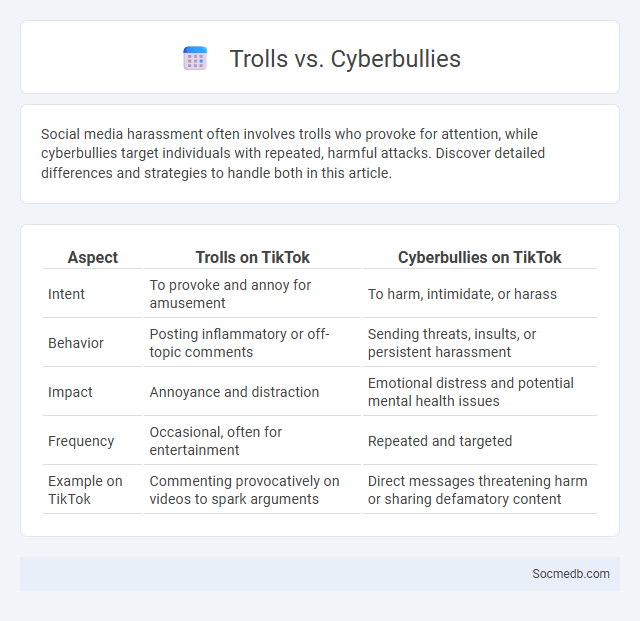
Photo illustration: Trolls vs Cyberbullies
Social media harassment often involves trolls who provoke for attention, while cyberbullies target individuals with repeated, harmful attacks. Discover detailed differences and strategies to handle both in this article.
Table of Comparison
| Aspect | Trolls on TikTok | Cyberbullies on TikTok |
|---|---|---|
| Intent | To provoke and annoy for amusement | To harm, intimidate, or harass |
| Behavior | Posting inflammatory or off-topic comments | Sending threats, insults, or persistent harassment |
| Impact | Annoyance and distraction | Emotional distress and potential mental health issues |
| Frequency | Occasional, often for entertainment | Repeated and targeted |
| Example on TikTok | Commenting provocatively on videos to spark arguments | Direct messages threatening harm or sharing defamatory content |
Understanding Trolls: Definition and Characteristics
Trolls are individuals who intentionally provoke or disrupt online conversations by posting inflammatory, irrelevant, or offensive messages across social media platforms. Recognizing the characteristics of trolls, such as anonymity, persistence, and a desire to evoke emotional responses, helps you navigate interactions more safely and maintain a positive online environment. Understanding these behaviors is essential for managing and mitigating digital harassment in social communities.
Who Are Cyberbullies? Key Features Explained
Cyberbullies are individuals who use digital platforms to harass, intimidate, or threaten others, often hiding behind anonymity. Key features include repetitive harmful behavior, targeting vulnerabilities, and exploiting social media's wide reach to amplify their attacks. Understanding these traits helps you recognize and protect yourself from online abuse effectively.
Trolls vs Cyberbullies: Core Differences
Trolls provoke conflict and disrupt online conversations for amusement, often targeting groups or individuals anonymously, whereas cyberbullies engage in repeated, targeted harassment aimed at causing emotional harm to a specific victim. Your ability to recognize these core differences can help in developing effective strategies for reporting and managing harmful interactions on social media platforms. Understanding troll behavior focuses on disruption, while identifying cyberbullying involves recognizing patterns of sustained abuse.
Psychological Motivations Behind Trolling
Trolling on social media often stems from psychological motivations such as the desire for attention, power, and social dominance. Individuals engage in disruptive behavior to provoke emotional responses and gain a sense of control or superiority over others. This behavior is also linked to underlying issues like low self-esteem, social anxiety, or a need for validation within digital communities.
Why Do People Become Cyberbullies?
People become cyberbullies due to a combination of psychological factors such as a desire for power, anonymity, and lack of empathy. Social media platforms often provide a convenient outlet for expressing aggression without immediate consequences or face-to-face accountability. Influences like peer pressure, low self-esteem, and exposure to violent online content further contribute to the prevalence of cyberbullying behavior.
Social Media Platforms: Hotspots for Trolls and Cyberbullies
Social media platforms are prime hotspots for trolls and cyberbullies, with sites like Twitter, Facebook, and Instagram experiencing high volumes of toxic interactions daily. Algorithms often amplify controversial or aggressive content, increasing your exposure to harmful behavior. Protecting your online presence requires vigilance, privacy settings, and reporting mechanisms to minimize the impact of cyberbullying.
Impact of Trolling on Victims
Trolling on social media platforms can have severe psychological effects on victims, including anxiety, depression, and decreased self-esteem. Harassment and negative comments often lead to social withdrawal and hinder a person's ability to engage confidently online. Protecting Your mental health requires awareness of these risks and proactive measures to manage online interactions.
Consequences of Cyberbullying: Mental Health Effects
Cyberbullying on social media platforms significantly impacts mental health, leading to increased rates of anxiety, depression, and suicidal ideation among victims. Prolonged exposure to online harassment disrupts emotional well-being and self-esteem, potentially resulting in long-term psychological trauma. Studies indicate that adolescents and young adults are particularly vulnerable, with cyberbullying contributing to social withdrawal and academic decline.
Prevention and Reporting: Dealing With Online Abuse
Preventing online abuse requires implementing robust privacy settings and educating users about recognizing harmful behaviors on social media platforms. Reporting mechanisms should be accessible and efficient, allowing victims to quickly flag and document incidents of harassment or threats. Social media companies must continuously update policies and employ AI tools to detect and mitigate abusive content proactively.
Creating a Safer Digital Community
Creating a safer digital community requires implementing strong privacy settings, promoting respectful interactions, and reporting harmful content promptly. You can protect yourself and others by being mindful of the information shared and supporting platforms that prioritize user security. Encouraging education about online etiquette and digital literacy helps reduce cyberbullying and misinformation, fostering a trustworthy social media environment.
 socmedb.com
socmedb.com